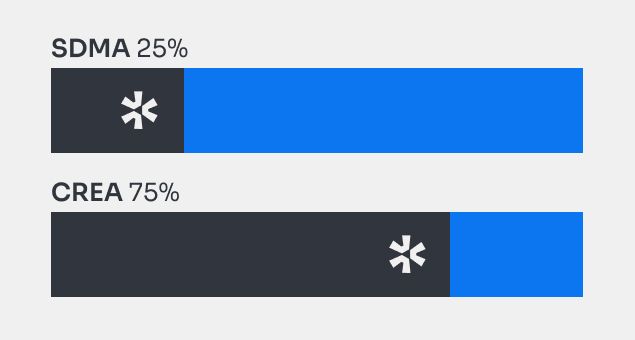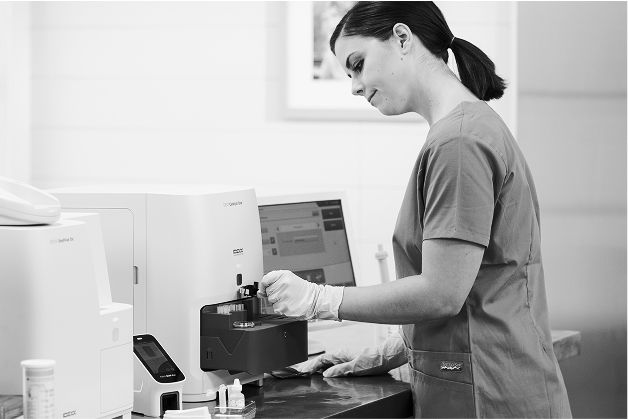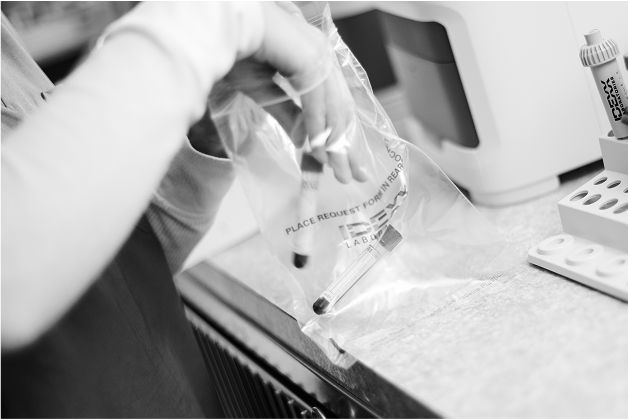
IDEXX SDMA testing
SDMA gives you earlier insights to kidney health that go beyond CKD.
Kidney disease has an early warning system.
When kidney function starts to decline, SDMA is the first to notice, which can have a positive impact on diagnosis, treatment, and outcomes. As glomerular filtration rate (GFR) declines, SDMA increases when kidney function decreases by an average of 40% and as little as 25%. In contrast, creatinine does not increase until up to 75% of kidney function is lost.1–3 That makes even slight changes meaningful. SDMA doesn’t just help spot chronic kidney disease (CKD)—it gives you a clearer picture of overall kidney health. SDMA serves as a reliable, routine part of kidney health evaluation, along with creatinine and BUN.

SDMA detects kidney issues when renal function has declined as little as 25%.
VS.
Creatinine only detects kidney issues when renal decline has already reached 75%.
*Renal decline

Even a mildly elevated SDMA result may signal trouble ahead.
Nearly half of dogs and cats of all ages experienced increased renal biomarkers within one year following a mild increase in SDMA, despite starting within the normal range.4
Let SDMA tell you more about your patients.
Because the kidneys are sensitive to various stresses, SDMA can be an early indicator of primary kidney diseases as well as the impact of other illnesses on kidney health.†
Diseases of the kidneys
- Chronic kidney disease
- Acute kidney injury
- Pyelonephritis
- Urolithiasis
- Glomerulonephritis
- Congenital disease
Disease processes affecting the kidneys
- Hyperthyroidism
- Vector-borne disease
- Systemic hypertension
- Cardiorenal syndrome
- Lower urinary obstruction
- Sepsis
- Cancer
- Drug toxicity
The many advantages of SDMA are backed by peer-reviewed studies.
Less impacted by extrarenal factors1,5
Unlike creatinine and urea, SDMA is not affected by factors that can overestimate GFR. SDMA is specific for kidney function and less impacted by extrarenal factors, including body condition, advanced age, and disease state.
More reliable than creatinine1–3,5,6
Because SDMA isn’t affected by factors like muscle mass, diet, and sex, it’s more reliable than creatinine in assessing kidney function in aging cats with muscle wasting.4,5
Increases earlier than creatinine in cats6
Results of a retrospective longitudinal study6 that includes 21 cats with CKD show that SDMA increased 17 months earlier than serum creatinine on average (range 1.5–48 months).
Increases earlier than creatinine in dogs2
SDMA increases earlier than creatinine in dogs with CKD. Results of a retrospective longitudinal study3 that includes 19 dogs with CKD show that SDMA increased 9.8 months earlier than serum creatinine on average (range 2.2–27 months).

Keep these 5 patients top of mind.
Nearly any patient can benefit from SDMA. Here are the 5 patients that can benefit most.
Healthy pets during routine check-ups.
Establish a baseline because a lack of clinical signs doesn’t necessarily indicate good health.
Cats with hyperthyroidism.
A significant number of cats with hyperthyroidism have concurrent kidney disease, as both conditions are common in older cats.10
Preanesthetic patients.
SDMA can improve recognition of at-risk patients and allow for well-informed and educated decisions regarding anesthetic choices and timing.
Patients that test positive for infections and vector-borne disease exposure.
Including SDMA testing with diagnostic profiles for patients that test positive for exposure to tick-borne disease can increase awareness of long-term health considerations.7–9
Patients presenting for nonwellness visits.
Monitoring kidney health is vitally important to any patient presenting with a medical issue. Treatment success is dependent upon management both during and after a medical event.
For a deeper dive into the data and research behind each of these patient cases and how SDMA can help, download the guide.
Two ways to unlock insights.

In-house laboratory
The Catalyst SDMA Test gives you in-house speed with flexible profiles tailored to your patients and practice.

Reference laboratory
With IDEXX Reference Laboratories, SDMA is included in every chemistry panel or can be ordered on its own.
FAQs
Three key attributes make the IDEXX SDMA Test an ideal test for assessing kidney function:
Biomarker for kidney function: Symmetric dimethylarginine (SDMA) is excreted by the kidneys. SDMA is an earlier indicator of changes in glomerular filtration rate (GFR) in dogs and cats.2,3,6,11
Earlier than creatinine: SDMA increases as early as 25% loss of kidney function,3 making SDMA more reliable in both acute or active kidney injury and chronic kidney disease.2,3,6 Creatinine cannot identify kidney issues until almost 75% of kidney function is lost.2,6
Specific for kidney function: SDMA is less impacted by extrarenal factors than creatinine, including body condition, advanced age, and disease state.1,5
SDMA is also not affected by lean body mass, making it more reliable for assessing kidney function in animals with chronic kidney disease or other conditions that result in weight and muscle loss, such as hyperthyroidism.1,5,11
SDMA is highly sensitive with studies supporting sensitivity as high as 100%.6,12–14
Creatinine: SDMA is a reliable and sensitive indicator of kidney function in animals. SDMA increases earlier than creatinine in dogs and cats with both AKI and CKD,2,3,6 and unlike creatinine, SDMA is not impacted by lean muscle mass.1,5 SDMA increases on average with 40% loss of kidney function vs. creatinine,2,6 which does not increase until up to 75% of kidney function is lost.2,6 Creatinine is a breakdown product of muscle, and therefore, it is impacted by lean body mass, whereas SDMA is not.5
Blood urea nitrogen (BUN): BUN also increases later than SDMA, and it can be influenced by decreased production in liver disease and increases with high-protein meals or gastrointestinal bleeding vs. SDMA, with little to no extrarenal impacts.5
Urine specific gravity (USG): Loss of urine concentrating ability progresses with kidney disease and dysfunction, and it is apparent before metabolic wastes, such as BUN and creatinine, increase. This change occurs with approximately 67% loss of nephron function but is variable.15 SDMA may increase in patients with early kidney disease that can still concentrate their urine. Natural fluctuations in USG are common in healthy animals and are influenced by how much the animal drinks before urine collection. Poor urine concentration is not specific to the kidney, and it can be influenced by other diseases (e.g., diabetes, liver disease, and Cushing’s disease), whereas SDMA is influenced by changes in GFR.12 Finding a persistently increased IDEXX SDMA concentration and inappropriately concentrated urine suggests kidney disease is probable, and immediate action should be taken.4
Urine protein:creatinine (UPC) ratio: The UPC ratio is a urine test. It is used to fully quantify protein detected in the urine once transient proteinuria, urinary tract infection, inflammation, or significant hematuria have been ruled out. The UPC ratio may detect kidney disease earlier than creatinine if the primary target of the disease is the glomerulus and in some cases of tubulointerstitial disease. However, it is common for the UPC ratio to remain normal in animals with CKD, especially in early stages when SDMA may be increased. Persistent proteinuria that results in UPC ratios greater than 0.4 in cats and 0.5 in dogs, where prerenal and postrenal proteinuria have been ruled out, is consistent with glomerular or tubulointerstitial CKD, whereas UPC ratios greater than 2.0 are strongly suggestive of glomerular disease. In animals with proteinuria, the UPC ratio should be used to monitor progression and response to treatment.16
SDMA is excreted from the kidneys; therefore, as kidney function or GFR decreases, SDMA increases. Studies have shown a very strong correlation between SDMA and GFR in dogs and cats.2,6 A benefit of using SDMA along with creatinine, which typically increases above the reference interval when there is up to a 75% reduction in GFR,2,6 is that SDMA increases when there is, on average, a 40% decrease in GFR.2,6 In some cases, SDMA increases earlier when there is 25% reduction of GFR, representing 25% loss of kidney function.3,6
Performing a GFR clearance test is the gold standard for measuring GFR and assessing kidney function. However, performing a GFR clearance test is expensive, cumbersome, and not routinely done in practice.
SDMA correlates well with GFR, increasing when there is, on average, a 40% loss of kidney function,2,6 and as little as 25% loss.3 Reduced urine concentrating ability typically appears when there is, on average, a 67% loss of GFR, but this is variable.17 Cats with experimentally induced kidney disease retained concentrating ability despite loss of 75% of renal mass.18 Given the lack of correlation between GFR and USG, a linear relationship between SDMA and USG could not be expected.
SDMA will, however, typically increase before isosthenuria associated with renal dysfunction develops. In many cases of early CKD, where SDMA is increased but creatinine is normal, the dog or cat will have an inappropriate USG (i.e., less than 1.030 for dogs or less than 1.035 for cats). However, in more than 25% of dogs and cats with an increased SDMA, significant urine concentrating ability will still remain because their GFR is only mildly decreased, or because of the variable timing of loss of concentrating ability. In patients with persistently increased SDMA where dehydration has been excluded, kidney disease is probable and should be further investigated, even if appropriate urine concentrating ability is noted.4
Untreated hyperthyroid cats have increased glomerular filtration rate (GFR) and loss of muscle mass secondary to their hyperthyroidism, which can hide underlying CKD. The IDEXX SDMA Test is a more reliable indicator of kidney function than creatinine in hyperthyroidism because, unlike creatinine, the IDEXX SDMA Test is not affected by lean body mass and appears to be only slightly blunted by hyperfiltration.19,20
Learn more about the comprehensive kidney care diagnostics and support available from IDEXX.
Note: SDMA is symmetric dimethylarginine.
†These IDEXX SDMA medical claims are supported by extensive scientific evidence.
References
- Hall JA, Yerramilli M, Obare E, Yerramilli M, Yu S, Jewell DE. Comparison of serum concentrations of symmetric dimethylarginine and creatinine as kidney function biomarkers in healthy geriatric cats fed reduced protein foods enriched with fish oil, L-carnitine, and medium-chain triglycerides. Vet J. 2014;202(3):588–596. doi:10.1016/j.tvjl.2014.10.021
- Hall JA, Yerramilli M, Obare E, Yerramilli M, Almes K, Jewell DE. Serum concentrations of symmetric dimethylarginine and creatinine in dogs with naturally occurring chronic kidney disease. J Vet Intern Med. 2016;30(3):794–802. doi:10.1111/jvim.13942
- Nabity MB, Lees GE, Boggess MM, et al. Symmetric dimethylarginine assay validation, stability, and evaluation as a marker for the early detection of chronic kidney disease in dogs. J Vet Intern Med. 2015;29(4):1036–1044. doi:10.1111/jvim.12835
- Mack RM, Hegarty E, McCrann DJ, Michael HT, Grauer GF. Longitudinal evaluation of symmetric dimethylarginine and concordance of kidney biomarkers in cats and dogs. Vet J. 2021;276:105732. doi:10:1016/j.tvjl.2021.105732
- Hall JA, Yerramilli M, Obare E, Yerramilli M, Melendez LD, Jewell DE. Relationship between lean body mass and serum renal biomarkers in healthy dogs. J Vet Intern Med. 2015;29(3):808–814. doi:10.1111/jvim.12607
- Hall JA, Yerramilli M, Obare E, Yerramilli M, Jewell DE. Comparison of serum concentrations of symmetric dimethylarginine and creatinine as kidney function biomarkers in cats with chronic kidney disease. J Vet Intern Med. 2014;28(6):1676–1683. doi:10.1111/jvim.12445
- Burton W, Drake C, Ogeer J, et al. Association between exposure to Ehrlichia spp. and risk of developing chronic kidney disease in dogs. J Am Anim Hosp Assoc. 2020;56(3):159–164. doi:10.5326/JAAHA-MS-7012
- Drake C, Coyne M, McCrann DJ, Buch J, Mack R. Risk of development of chronic kidney disease after exposure to Borrelia burgdorferi and Anaplasma spp. Top Companion Anim Med. 2021;42:100491. doi:10.1016/j.tcam.2020.100491
- Little S, Levy J, Hartmann K, et al. 2020 AAFP feline retrovirus testing and management guidelines. J Feline Med Surg. 2020;22(1):5–30. doi:10.1177/1098612X19895940
- Vaske HH, Schermerhorn T, Grauer GF. Effects of feline hyperthyroidism on kidney function: a review. J Feline Med Surg. 2016;18(2):55–59. doi:10.1177/1098612X15575385
- DeMonaco SM, Panciera DL, Morre WA, Conway T, Werre S. Symmetric dimethylarginine in hyperthyroid cats before and after treatment with radioactive iodine. J Feline Med Surg. 2020;22(6):531–538. doi:10.1177/1098612X19859947
- Sargent HJ, Elliott J, Jepson RE. The new age of renal biomarkers: does SDMA solve all of our problems? J Small Anim Pract. 2021;62(2):71–81. doi:10.1111/jsap.13236
- McKenna M, Pelligand L, Elliott J, Cotter D, Jepson R. Relationship between serum iohexol clearance, serum SDMA concentration, and serum creatinine concentration in non-azotemic dogs. J Vet Intern Med. 2020;34(1):186–194. doi:10.1111/jvim.15659
- Brans M, Daminet S, Mortier F, Duchateau L, Lefebvre HP, Paepe D. Plasma symmetric dimethylarginine and creatinine concentrations and glomerular filtration rate in cats with normal and decreased renal function. J Vet Intern Med. 2021;35(1):303–311. doi:10.1111/jvim.15975
- Lulich JP, Osborne CA, O’Brien TD, Polzin DJ. Feline renal failure: questions, answers, questions. Compend Contin Educ Pract Vet. 1992;14(2)127–153.
- IRIS Canine GN Study Group Diagnosis Subgroup, Littman MP, Daminet S, Grauer GF, Lees GE, van Dongen AM. Consensus recommendations for the diagnostic investigation of dogs with suspected glomerular disease. J Vet Intern Med. 2013;27(Supp 1):S19–S26. doi:10.1111/jvim.12223
- Rytlewski K, Olszanecki R, Korbut R, Zdebski Z. Effects of prolonged oral supplementation with L-arginine on blood pressure and nitric oxide synthesis in preeclampsia. Eur J Clin Invest. 2005; 35(1):32–37. doi:10.1111/j.1365-2362.2005.01445.x
- DiBartola SP, Rutgers HC, Zack PM, Tarr MJ. Clinicopathologic findings associated with chronic renal disease in cats: 74 cases (1973–1984). JAVMA. 1987;190(9):1196–1202.
- Szlosek D, Robertson J, Quimby J, et al. A retrospective evaluation of the relationship between symmetric dimethylarginine, creatinine and body weight in hyperthyroid cats. PLoS One. 2020;15(1):e0227964. doi:10.1371/journal.pone.0227964
- Peterson M, Varela F, Rishniw M, and Polzin DJ. Evaluation of serum symmetric dimethylarginine concentration as a marker for masked chronic kidney disease in cats with hyperthyroidism. J Vet Intern Med. 2018;32(1):295–304. doi:10.1111/jvim.15036